#Family: Labridae
Explore tagged Tumblr posts
Text
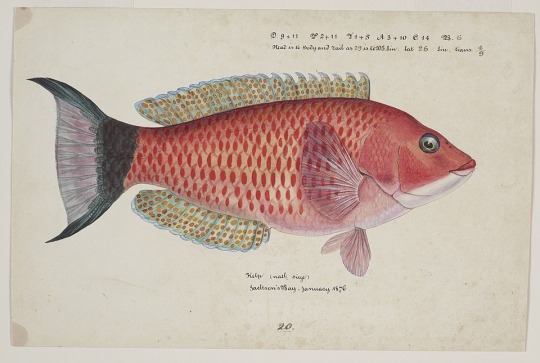
Range: Waters around New Zealand
#poll#Class: Actinopterygii#Order: Labriformes#Family: Labridae#Genus: Pseudolabrus#Pseudolabrus Miles
22 notes
·
View notes
Text
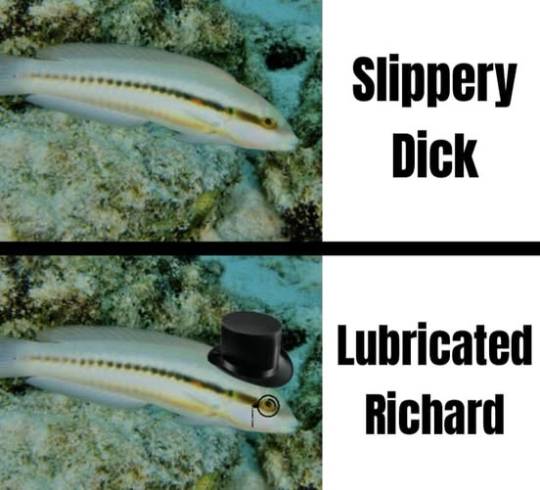
Slippery Dick (Halichoeres bivittatus), family Labridae, order Labriformes, found in the tropical western Atlantic
Like many wrasses, this fish is a protogynous hermaphrodite, starting life as a female, and becoming male later in life.
photograph by Florent Charpin
772 notes
·
View notes
Text
Wet Beast Wednesday: California Sheephead Wrasse
A lot of people through history and the modern day have an overly simplistic view about sex, both in the sense of biological sex (that is, what gametes something produces) and sex as in the act of mating. A lot of people think that sex is just a strict binary between males and females, but nature is far more diverse and varied than that (even in humans. Intersex people do exist after all). Today I'm showcasing one of the animals that completely goes against the alleged sex binary: the California Sheephead Wrasse. And yes, this is a pride post.

(Image: a male California Sheephead Wrasse in a tank in the Monterey Bay Aquarium. It is a large fish with a bulbous head. The head and tail are black, midsection is pink, and the belly and chin are white. End ID)
The California Sheephead (Semicossyphus pulcher) is a large fish in the Wrasse family of Labridae. They are sexually dimorphic, with the males and females appearing distinct from each other in size, shape, and color. Males are larger than females, reaching up to 91 cm (3 ft) and 16 kg (35 lbs), though there is quite a bit of size variation based on food availability. They have flatter faces than females thanks to a bulbous bump on the forehead. This lump is the namesake of the fish, since it allegedly make it look like it has a sheep's head. I personally don't see it at all. Males have black heads and tails with a white chin and underbelly and pink midsection Females are smaller and colored silvery to a dull pink all over except for their white chins and underbellies. There isn't really a maximum size or weight for females for reasons I'll get into later. The fish have large canine teeth that protrude from the mouth and modified throat bones that form a grinding apparatus called the throat plate.
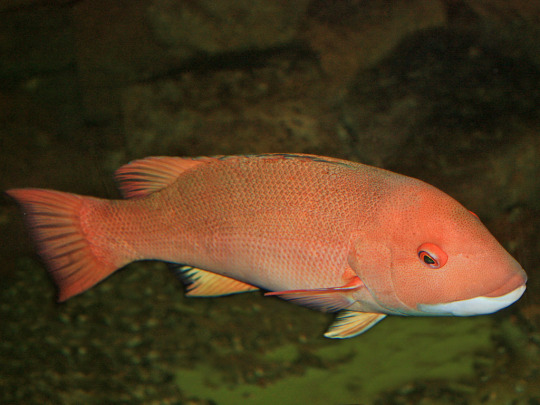
(Image: a female California Sheephead. It has a less bulbous head than the male and is a pale pink all over, except for the white belly and chin. End ID)
Sheepheads, like many wrasses, are sequential hermaphrodites. A sequential hermaphrodite can transition between sexes during its life (as opposed to a simultaneous hermaphrodite, who can produce both sperm and eggs at the same time). Every California Sheephead is born female and some will become male later in life, making them protogynous. Protogyny is the most common form of hermaphroditism in fish, with over 75% of known sequentially hermaphroditic fish species being protogynous. This transition is a one-way process, males will not turn back into females. The transition is triggered by a number of factors, primarily size and the local availability of males. If there are not enough males in the area, the largest female will transition to male to fill the role. This transition takes between 2 weeks and a few months depending on availability of food and other conditions (temperature seems to play a role) and the fish will be capable of producing sperm before fully assuming the male morphology.
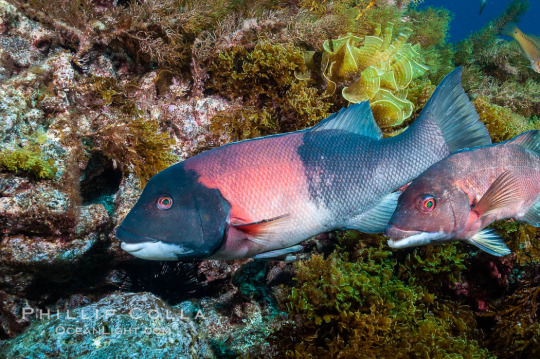
(Image a male and female Sheephead swimming next to each other. The female is roughly half the size of the male. End ID)
During mating season (July-September), males will pick a territory and claim all nearby females as mates. A younger male without a territory may challenge an alpha male to try to claim his territory. These fights are often resolved with threat posturing, but if neither male backs down, they will fight with biting and raking teeth against the opponent. During mating season, females will release batches of 375,000 eggs almost daily for males to fertilize. During this time, the alpha male will patrol his territory to mate as much as possible while chasing off smaller males who may attempt to sneakily fertilize some of his female's eggs. The larvae are planktonic for their first 34-78 days, and will sink as they grow. Juveniles have a different coloration to the adults. They are orange, with a white stripe running down the body and dark spots on the fins. The average maximum age of a California Sheephead is 21 years, but the oldest individual on record was 53 at the time of capture.
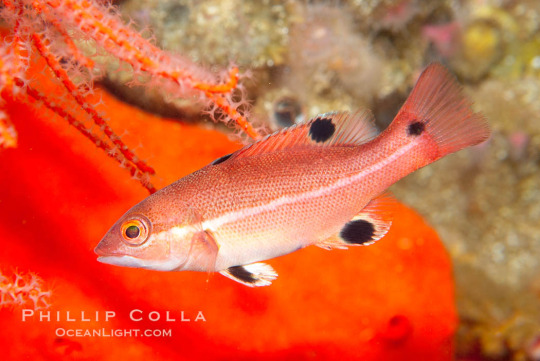
(Image: a juvenile Sheephead. It is a small, orange fish with a white stripe running from eye to tail and black spots on the pelvic, anal, dorsal, and tail fins. End ID)
The California Sheephead lives on rocky reefs and kelp forests from southern California to the Baja peninsula and Gulf of California. They prefer shallow water between 3 and 30 meters (10 - 100 ft) deep, though males will occasionally venture deeper. Sheepheads are predators that hunt hard-bodies invertebrates including urchins, shelled molluscs, and crabs. Juveniles hunt smaller prey such as sponges, bryozoans, and barnacles. The protruding canines give the fish a better grip when trying to pry food off of rocks. They crush the hard shells of the prey with sharp teeth before swallowing. The shells are then further ground down by the throat plates. Smaller individuals have been known to break open urchins too large to bit by picking them up and hammering them into rocks. Sheepheads play an important role in kelp forest ecosystems by keeping urchin populations down. Urchins eat kelp and without predators keeping their numbers in check, can reduce kelp forests to urchin barrens. Sheepheads are known to have a high site fidelity, meaning they will return to the same places over and over. They will maintains a sleeping spot (usually a crevice they can hide in or rock they can hide under) and return to the same places to hunt. They are diurnal and return to their sleeping spots at night to avoid predators.

(Image: a male Sheephead trying to pick up a sea urchin with tis mouth. End ID)
California Sheephead Wrasses are classified as vulnerable to extinction by the IUCN. Their primary threat is overfishing. The Sheepheads have been commercially fished since the 1800s and their numbers have dropped. The hermaphroditic nature of the species actually makes things worse. Commercial fishers are incentivized to catch the largest fish and the largest Sheepheads are the males and females that are likely to transition to male. Unlike with other species, there aren't small males around to make up for the loss of large males to fishing since the small fish are the females. The loss of males and the largest females (who are the ones most likely to transition to male) means there aren't enough males around during mating season to keep the population high enough. The introduction of marine protected areas and fishing regulations have helped the population recover. The loss of the Sheepheads is a big deal since they're one of the species doing the most to keep the kelp forests healthy by eating urchins. Natural predators of the Sheepheads include sharks, sea lions, and giant sea bass.

(Image: a fisherman holding a male Sheephead on a boat. The large canines of the fish are particularly visible. End ID)
#wet beast wednesday#transmasc icons#california sheephead wrasse#sheephead wrasse#wrasse#fish#fishblr#fishposting#pride#hermaphrodite#sequential hermaphroditism#protogyny#marine biology#biology#zoology#ecology#animal facts#educational#informative#image described
100 notes
·
View notes
Text
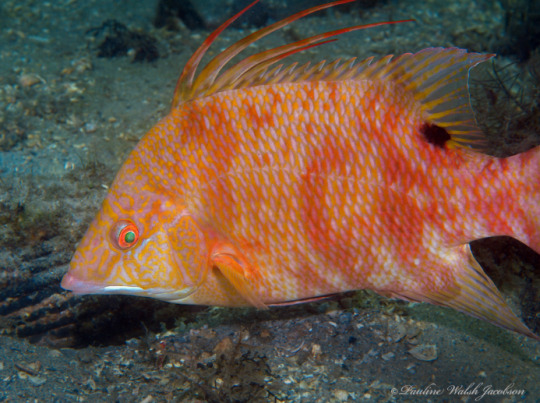
Hogfish (Lachnolaimus maximus)
Family: Wrasse Family (Labridae)
IUCN Conservation Status: Vulnerable
Named for its elongated snout which it uses to root through sediment in search of crabs and other seabed-dwelling prey, the Hogfish is a unique species of wrasse native to the western Atlantic Ocean, where it mainly inhabits areas near coral reefs (particularly reefs dominated by soft corals.) All Hogfishes are born as females, but as they progress through their lives some may develop into males upon reaching older age; members of this species live in small schools consisting of numerous small females and a single large male (which can be distinguished from the females around him by his larger size, darker colouration, longer fin spines and the distinctive black spot near the base of his tail,) responsible for fertilizing all the group's eggs, and in the event of the school's male dying or otherwise being separated from the rest of the group the largest, oldest remaining female will lose the ability to lay eggs, increase in size, develop the colouration of a male and gain the ability to produce sperm, taking his place. In addition to changing in colouration when changing sex, Hogfishes are also known to be capable of changing colour in order to avoid detection by predators (taking on duller colouration to match their surroundings upon spotting predators such as Sand Tiger Sharks,) and surprisingly it seems this colour-changing ability is managed purely by the chromatophores (colour-changing cells) in their skin with little input from the brain, as the skin will continue to change colour to match its surroundings for a short period even after being removed from the fish's body.
--------------------------------------------------------------------------
Image Source: https://www.inaturalist.org/taxa/49432-Lachnolaimus-maximus
#Hogfish#hogfish#wrasse#wrasses#zoology#biology#icthyology#marine biology#animal#animals#fish#fishes#marine wildlife#north american wildlife#wildlife#bony fish#bony fishes
148 notes
·
View notes
Text
First Fish Yap Post - Labridae!
I figure it fit for the first post in this blog to be about my favourite fish family ever - Labridae - the wrasses, parrotfishes and cales.
Introduction Labridae is a diverse (and extremely cool!) family of fishes, encompassing nearly 700 species, and occur in tropical and temperate marine waters worldwide - none inhabit freshwater. Typically, they are elongate, small to medium in size and colourful, and the greatest species diversity is found on tropical coral reefs.

This green fellow is Thalassoma lunare - the Moon Wrasse. By all means, a fairly 'typical' wrasse.
Taxonomy The number of species included within Labridae has increased over time, not only by the description of new species, but also from species from other families being reclassified as members of Labridae - notably, the parrotfishes (formerly family Scaridae) and the cales (formerly family Odacidae). The parrotfishes and cales were always considered to be close relatives of Labridae, but genetic studies have shown that these groups are deeply nested within Labridae, and thus should be classified in this family. The closest living relatives of Labridae, based on genetic evidence, appears to be the curious family Centrogenyidae, the false scorpionfishes.

This is Scarus rivulatus - the Surf Parrotfish. Formerly placed in the family Scaridae, but along with all other parrotfishes, is now included in Labridae

Siphonognathus caninis - the Sharp-nosed Weed-whiting. Formerly placed in Odacidae (a family of temperate marine fishes found only in southern Australia and New Zealand), but along with all other Odacidae species is now included in Labridae.
Diets and Feeding This is where the labrids really get interesting. The vast majority of labrids are carnivorous - typically subsisting on crustaceans, molluscs and other invertebrate prey. The 'typical' carnivorous wrasses possess simple, peglike teeth to break down their (often shelled) prey, but many groups show interesting specialisations to the mouth, jaws and teeth to exploit other food sources.
The aforementioned parrotfishes and cales are largely herbivorous, and have specialised tooth structures to facilitate this diet - in parrotfishes, their teeth have fused into a thick, parrot-like beak to scrape algae from rocks. In doing this, the top layer of rock is also scraped off and ingested, to be later excreted as the fine white sand on tropical beaches that humans find so appealing. So next time you find yourself on a gorgeous tropical beach, don't forget that you're standing on a giant accumulated mound of parrotfish poo! The cales take a similar but different approach to herbivory - they too have fused beaklike teeth, but use them like a pair of garden shears to clip mouthfuls of algae and seaweed.
Some wrasses are plankivorous, aggregating in shoals that hover at the edge of the reef to pick at plankton floating by on the currents - this guild includes the likes of the genus Cirrhilabrus and smaller species of Thalassoma.
The Slingjaw Wrasse (Epibulus insidiator) has a most unusual mouth structure that allows it to massively extend it's jaws, forming a frankly absurd tubelike structure to allow it to slurp up small fish and shrimp that may be hiding in small crevices. The ability to protrude the mouth out like this is common amongst ray-finned fishes, but few can do so to the ridiculous extent of the Slingjaw Wrasse. I HIGHLY recommend looking up a video of the slingjaw in action, it's super cool.

Epibulus indidiator (Slingjaw Wrasse) showing off it's frankly absurd jaw protrusion. When the jaws are retracted, they sit flat against the rest of the head.
The various species of tubelip wrasses are specialists on a very strange diet - the mucus secreted by corals. As the name suggests, these fishes have unusually long and fleshy lips that come together to form a sealed tube, with which the fish uses to create a tight seal against a piece of coral and sucks up the mucus.

Labrichthys unilineatus, one such species of tubelip wrasse. Look at those lips!
Perhaps the best-known feeding specialisation in wrasses is that of species that clean other fishes of parasites, food waste and dead skin. Many wrasse species engage in cleaning behaviour as juveniles, but a few (such as the genus Labroides, the well-known 'cleaner wrasses') continue this behaviour into adulthood, and make it their primary source of sustenance. These small, striped wrasses will set up 'cleaning stations' on the reef, attended by one or more cleaner wrasses - typically, a reef with have several of these stations. Most sedentary fish species will simply visit the cleaning station closest to their territory, but wider-ranging species are willing to travel considerable distance to visit the stations that offer the best service, so competition between cleaning stations is fierce to provide the best services to win these picky customers. The cleaner wrasses will give preferential treatment to non-local fish to win their favour, and can individually recognise hundreds of fishy customers from different species. Even large, predatory fish species are accepted customers, and the cleaner wrasses will happily enter the mouths and gills of groupers, sharks and eels to clean them. Only on very rare occasions will such a predator eat a cleaner wrasse - the benefit of the wrasse's cleaning services is greater to the predator than the immediate caloric benefit of consuming the wrasse, so the wrasse can swim straight into the mouth of predatory fish with impunity.

Labroides dimidiatus (Bluestreak Cleaner Wrasse), the best-known species of the genus Labroides.
Sex-swapping and Reproductive Strategies An extremely interesting (but not entirely unique) trait of the wrasses is their ability to change sex, and the reproductive systems this enables. Almost all wrasses are born females, and can become male later in life. Often, juvenile female wrasses will join harems, consisting of numerous juveniles and adult females, and a single male. In these harems, there is a strict dominance hierarchy, with each fish harassing those lower in the ranks than itself. This constant low-level stress inhibits the hormone production that would cause a female wrasse to transition into a male - except for the most dominant fish, which is free to transform into a male. Usually, the dominant male will bear different colouration and patterning to the other fish in the harem, making the boss easy to pick out from the rest. The dominant male in a wrasse harem will frequently spawn with the adult females. However, if the dominant fish is removed from the harem (eg. if he dies, or is kicked out after losing a dominance contest to another wrasse), the most dominant female will become male to take his place. The behavioural change is almost instantaneous - the new dominant fish will become more aggressive - but the change in colouration and gonads can take a few weeks to a few months.

Female Thalassoma amblycephalum (Blunthead Wrasse)

Dominant male of the same species. It's easy to see how often, male and female of the same wrasse species can be incorrectly identified as being different species - even by scientists!
Intelligence and Tool Use Perhaps, 'intelligent' is not a word often used to describe fishes, but wrasses would certainly be among the brainiest of the fishes. The previously mentioned Bluestreak Cleaner Wrasse is one of the few fish to have demonstrated self-awareness via the mirror test (although the mirror test has rarely been attempted on fishes, so perhaps the number of self-aware fish out there is higher than we realise), and several wrasse species (particularly the tuskfishes of the genus Choerodon) have been observed to use tools. Tuskfishes have a pretty fearsome set of teeth that they use to break through the shells of their prey, but that alone is not enough to break the thickest of clam shells - so they use tools to smash the clams. A tuskfish, upon finding a clam too solid to bite through, will carry it in it's mouth to a habitually used rock or knob of coral, and with the clam still in it's mouth, flick it's head to hit the clam against the rock to break it. Only rarely does this work the first try, but the tuskfish is persistent, and will repeatedly hit the clam until it breaks, allowing the fish entry to consume the flesh inside.

Choerodon anchorago (Anchor Tuskfish), one species that has been observed to use tools to break open clam shells.
Sleep Labrids have some pretty interesting behaviours to avoid being eaten while they sleep (although it could be argued fish do not truly 'sleep', saying 'sleep-like resting state' every time is too wordy so I'll just say 'sleep'). Many species will burrow into the sand to sleep, to hide from predators - a behaviour that can be alarming to the beginner saltwater aquarist, who may be terrified to find that their newly-acquired wrasse has suddenly dissappeared when the tank lights are turned off! Other species (especially the parrotfishes) produce a bubble of mucus to sleep in, like a sleeping bag made of snot. They make a new bubble every night, the purpose of which is to conceal the fish's scent from predators as it sleeps in a crevice or under a head of coral, as well as to prevent parasites settling on the fish's skin. In the morning, the fish will eat it's way out of it's mucus bubble.

A parrotfish (I'm not sure which species exactly) sleeping in it's mucus bubble.
Oh, and did I mention that some wrasses are drop-dead GORGEOUS???? Just LOOK at these

Cirrhilabrus hygroxerus - Monsoon Fairy Wrasse

Cirrhilabrus cyanopleura - Blueside Fairy Wrasse. This colour form of the species with the yellow spot on the flanks was previously considered a seperate species (Cirrhilabrus ryukyuensis), but has been reclassified as a colour variant of C. cyanopleura.

Macropharyngodon meleagris - Leopard Wrasse

Gomphosus varius - Pacific Bird Wrasse. Boy, why you so nose??

Cheilinus undulatus - Humphead Maori Wrasse. This is the largest species in the family Labridae (reaching a whopping 2.3 metres!), and unfortunately also one of the most threatened - it is heavily fished for the seafood trade, and it's slow growth makes it easily overharvested.

Lachnolaimus maximus - Hogfish
16 notes
·
View notes
Text








Parrotfish are a group of fish species traditionally regarded as a family (Scaridae), but now often treated as a subfamily (Scarinae) or tribe (Scarini) of the wrasses (Labridae). With roughly 95 species, this group's largest species richness is in the Indo-Pacific. They are found in coral reefs, rocky coasts, and seagrass beds, and can play a significant role in bioerosion.
Parrotfish are named for their dentition, which is distinct from other fish, including other labrids. Their numerous teeth are arranged in a tightly packed mosaic on the external surface of their jaw bones, forming a parrot-like beak with which they rasp algae from coral and other rocky substrates (which contributes to the process of bioerosion).
Maximum sizes vary within the group, with the majority of species reaching 30–50 cm (12–20 in) in length. However, a few species reach lengths in excess of 1 m (3 ft 3 in), and the green humphead parrotfish can reach up to 1.3 m (4 ft 3 in). The smallest species is the bluelip parrotfish (Cryptotomus roseus), which has a maximum size of 13 cm (5.1 in).
13 notes
·
View notes
Text
Kobudai



Name: Asian Sheepshead Wrasse / Kobudai
Scientific Name: Semicossyphus reticulatus
Family: Labridae
Location: "Native to the western Pacific Ocean, it inhabits rocky reef areas and prefers temperate waters around the Korean Peninsula, China, Japan, and the Ogasawara Islands."
Status: Data Deficient
Fun Facts:
• All Kobudai are born female, but they become male if they reach a length of about 50cm.
• They are able live for about 40-50 years typically, the females can reach 40cm long while the males can reach 100cm long.
• They are crucial to their habitats as they control sea urchin populations by eating them.

Sources: 🌊 / 🌊
#my mom requested this lol#marine life#sea creatures#marine biology#ocean#ocean creatures#ocean life#sea critters#sea life#info blog#sea creature of the week#kobudai#asian sheephead wrasse#wrasse
4 notes
·
View notes
Text








Parrotfish are a group of fish species traditionally regarded as a family (Scaridae), but now often treated as a subfamily (Scarinae) or tribe (Scarini) of the wrasses (Labridae). With roughly 95 species, this group's largest species richness is in the Indo-Pacific. They are found in coral reefs, rocky coasts, and seagrass beds, and can play a significant role in bioerosion.
Parrotfish are named for their dentition, which is distinct from other fish, including other labrids. Their numerous teeth are arranged in a tightly packed mosaic on the external surface of their jaw bones, forming a parrot-like beak with which they rasp algae from coral and other rocky substrates (which contributes to the process of bioerosion).
Maximum sizes vary within the group, with the majority of species reaching 30–50 cm (12–20 in) in length. However, a few species reach lengths in excess of 1 m (3 ft 3 in), and the green humphead parrotfish can reach up to 1.3 m (4 ft 3 in). The smallest species is the bluelip parrotfish (Cryptotomus roseus), which has a maximum size of 13 cm (5.1 in).
#shark-blog-stuff#sea life#horrorblog78#sea creatures#strawberrycake78#beauty of nature#nature#nature is lit
17 notes
·
View notes
Text
Animal Crossing Fish - Explained #233
Brought to you by a marine biologist who uses tools to get shit done...
CLICK HERE FOR THE AC FISH EXPLAINED MASTERPOST!
If you're familiar with the debate surrounding animal intelligence, you've probably heard about the many tests animals can be given to test their level of intelligence. These tests are how we have determined that dolphins and great apes are smart as hell while most other animals really aren't. Now, we don't have a lot of time to talk about intelligence, but please understand that intelligence, like any trait, is useful for some but not for others, and that doesn't make those others lesser. Anyway, one test for intelligence is the use of tools, and today's fish - the Blackspot Tuskfish - was the first fish discovered to do just that.
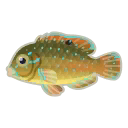
The Blackspot Tuskfish (acronym from now on - BSTF) appeared for a short while in Animal Crossing Pocket Camp for their Fishing Tourney #53, the Oasis Patio. This event occurred during August 2022, and the BSTF hasn't been seen since.
The BSTF is a species of wrasse belonging to Order Labriformes which includes the wrasses, parrotfish, and cales. These fish are most often associated with coral reef habitats and feed on a variety of organisms and algae, depending on species. Within Labriformes is Family Labridae which are the wrasses specifically. They are known to be incredibly colorful, and most are protogynous hermaphrodites, meaning they begin life as females and become male as they grow larger. Some, like the tuskfish (Genus Choerodon), have large, sharp teeth - "tusks" - and powerful jaws they use to crunch on bivalves and other hard prey. The BSTF (Choerodon schoenleinii) is a native to Indo-Pacific near-shore coral reefs, from East Africa out to various Pacific islands, where it does just that.

From https://fishesofaustralia.net.au/home/species/1928
When the BSTF finds a bivalve is just can't crack with its jaws alone, it goes looking for something to help it, like a rock it can smash the bivalve into. In July 2011, this behavior was finally documented, providing evidence to support the notion that wild fish can use tools. At least for BSTF, it was given that seal of approval, as using the rock to help it feed fit the accepted definition of tool use.
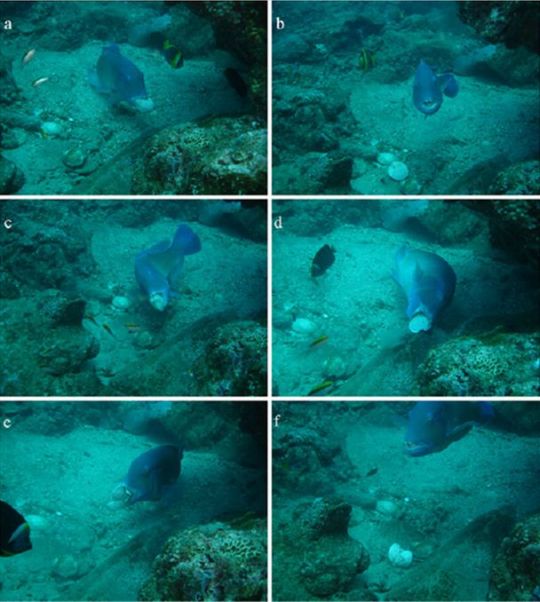
From https://phys.org/news/2011-07-photo-fish-tools.html
Fish are smarter than people give them credit for. At the end of the day, it's really hard to determine how smart a creature like a fish, that has evolved over millennia in an environment so unlike ours, is. We can't simply compare their intelligence to ours, nor should we snub our noses at animals that just don't have it. You wouldn't like it if a fish judged you based on how well you could breathe underwater.
And there you have it! Fascinating stuff, no?
#blackspot tuskfish#fish#animal crossing#animal crossing pocket camp#acpc#animals#marine biology#ocean#science#science in video games#animal crossing fish explained
4 notes
·
View notes
Text
Napoleon Wrasse Production and Trade: Insights from Bohol, Philippines

Abstract
Market survey of Napoleon wrasse is needed to gather and analyze the data of this species in the market. Napoleon wrasse (Cheilinus undulatus) locally known as “Mameng” is a small but significant component in fish trading. This study was conducted to determine the prevalence of Napoleon wrasse trading through market surveys in the selected municipalities of Bohol namely the municipality of Calape, Getafe, and Tubigon, as basis for conservation measures. Descriptive survey method was used in the study. A one month survey was done to the three municipalities, where the survey took place only every market days. Results showed that the volume of production of Napoleon wrasse in the three municipalities was very low, where the total volume of production of Napoleon wrasse during the one month survey was 1kg in the municipality of Calape, 3.5kg in the municipality of Getafe, and 7kg in the municipality of Tubigon. Most of the fish vendors in the three selected municipalities of Bohol can rarely sell Napoleon wrasse. The volume of consumption of Napoleon wrasse in the three municipalities during the one month survey was relatively high where all of the Napoleon wrasse the fish vendors were selling was sold and sought by buyers. The volume of production of Napoleon wrasse in the three selected municipalities of Bohol was very low due its rarity resulting to its high demand and consumption rate. Among of the three municipalities, only the municipality of Getafe had been identified to have the prevalence of Napoleon wrasse trading.

Introduction
The Napoleon wrasse (Cheilinus undulatus), locally known as “Mameng”, is one of the largest of all reef fishes and the biggest of the wrasse family, the Labridae. It can reach well over two meters in length and 200 kilograms in weight. This species is considered a gourmet food fish and is appreciated for the fine taste and texture of its flesh and it has become a small but significant component of the live reef food fish trade for it is one of the most highly valued species in the trade (Sadovy et al., 2003)
Napoleon wrasse has thick lips and a prominent bulbous hump on the forehead. The juveniles of this species can be identified by their pale greenish color and two black lines running behind the eye. Napoleon wrasse lives on lagoon reefs and steep outer reef slopes at depths of 1 to 60 meters, temperature of 25.71 to 28.98 and salinity of 34.38 to 35.31 ppt. Its primary foods are mollusks, fishes, sea urchins, crustaceans and other invertebrates. Napoleon wrasse is one of the few predators of toxic animals such as sea hares, box fishes and crown-of-thorns Starfish (Randall, Allen and Steen 1990). The longevity of this species is up to at least 32 years and sexual maturity is reached at about eight years of age, meaning they are extremely slow are extremely slow hermaphrodites, which means they can start their life as a female and then change to the male, with sex reversal occurring at about 15 years of age.
Because of its high value as food, it is heavily sought by fishers and traders. There is now a considerable concern that this widespread but uncommon species is being threatened that cause decline of its number because of the growing demand of this species in the live reef food fish trade. International Union for Conservation of Nature (IUCN) stated that the Napoleon wrasse is primarily taken for export as part of the valuable live reef food fish trade which is centered in Southeast Asia especially from Indonesia, Malaysia, and including the Philippines. As part of the live food fish market of these countries, Napoleon wrasse value is likely to increase with rarity, so fishers will continue to fish this species even as its numbers decline. Buyers of this fish also continually have to source new areas as numbers of this species decline in the particular area where they can buy this Napoleon fish. The rampant trading of Napoleon wrasse was happening elsewhere, so there is a need of conducting a research study regarding on the prevalence of Napoleon wrasse trading in the three municipalities of Calape, Getafe, and Tubigon through market surveys. A market survey is a process of gathering and analyzing data of a certain product in the market.
To gather and analyze data of Napoleon wrasse in the market, a market survey was conducted in order to better understand the status of this species in the market. There are no data on total numbers of this fish globally. However, adults reef area within its distribution and even in preferred habitats; densities are very low for a commercially exploited species (rarely > 10 fish per 10,000 square meter when not fished). It is considered uncommon to rare naturally. Nothing is known about the extent of subpopulations or degree of fragmentation but available suitable habitat is a major determinant of its distribution.
Moreover, Napoleon wrasse trade in Malaysia and found that there is extensive, illegal, unrecorded and unmonitored Napoleon wrasse trading occurring between Malaysia and the Philippines. They found that although the Philippines banned the export of all live fish, “the government of Malaysia is aware and has admitted that most of the Napoleon wrasse stock exported from Sabah in Malaysia is caught in the Philippines. There appears to be no monitoring or records kept of the trade of Napoleon wrasse between the Philippines and Sabah. The Napoleon wrasse’s inclusion in the list of Convention on International Trade in Endangered Species (CITES) Appendix II in the year 2004, with the listing, international trade is only permitted if the export will not be detrimental to the survival of the species in the wild has been unsuccessful in protecting the species from further decline. For example, the wrasse trade in the Malaysia is regulated, in part, by CITES and pursuant to this convention. CITES permits are required before one can export wrasse. Chen and Justin found that prior to 2007 there was only one record of an export of two live wrasse (Chen and Justin, 2009.
In Philippines, exports of the Napoleon wrasse are prohibited throughout the country. Until recently, the Napoleon wrasse could not be exported from Palawan with an exemption for the taking of small fish for mariculture (Philippines Fisheries Code, 1998).
Fishing through explosives noxious or poisonous substance, and / or electricity its shall be unlawful for any person to catch, take or gather or cause to be caught, taken or gathered, fish or any fishery species in Philippines waters with the use of electricity, explosives, noxious or poisonous substance such as sodium cyanide in the Philippines fishery areas which will kill, stupefy, disable or render unconscious fish or fishery species. Provided, that the Department, subject to such safeguards and conditions deemed necessary and endorsement from the concerned LGU’s may allow, for research, educational or scientific purposes only, take or gather fish or fishery species. Provide, further, that the use of poisonous or noxious substance to eradicate predators in fishponds in accordance with accepted scientific practices and grounds shall not be construed as illegal fishing (Philippine Fisheries Code, Section 88).
Market survey on Napoleon wrasse is described as the systematic and objective identification, collection analysis, and dissemination of information for the purpose of assisting management in decision making related to the identification and solution of the problems pertaining to this species. That is, to provide management with relevant, accurate, reliable, valid, and current information.
Source : Napoleon Wrasse Production and Trade: Insights from Bohol, Philippines | InformativeBD
1 note
·
View note
Text
List of Families within Labriformes I’ve covered (each link leads to the tags for each family):
Labridae
5 notes
·
View notes
Text

Harlequin Tuskfish (Choerodon fasciatus), family Labridae, order Labriformes, Great Barrier Reef, Cairns, Australia
photograph by Leonard Low
327 notes
·
View notes
Text
Marine creatures in coral reef ecosystem

Credit: Raavya Bhattacharyya
Hi. This is the fourth entry in the series of blogs about coral reefs. In this blog, we will look at the various fantastic marine creatures in the coral reef ecosystem. More than thousands of marine life interact with coral reefs, but we will only see some of them in the blog. Let's start exploring them.
Coral-feeding fishes
In addition to shelter and living spaces, corals are the food source of coral-feeding fishes (also known as corallivorous fishes) (Cole, Pratchett & Jones 2008). Among 128 corallivorous fishes from 11 families documented, 69 belong to the family Chaetodontidae. Other families include the Balistidae, Labridae, Monacanthidae, Pomacentridae, Scaridae and Tetraodontidae. Below are examples of fish species of the mentioned families. Some are not coral-feeding fishes. The pictures just show how the species will look in a particular family.
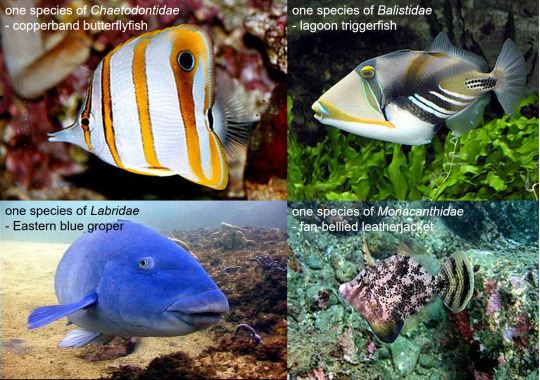

Credit: Wiktionary (Chaetodontidae); Wikipedia (Balistidae; Monacanthidae; Pomacentridae; Scaridae; Tetraodontidae); Tim Hochgrebe (Labridae).
One-third of them almost feed only on corals, which make up more than 80% of the diet. Regarding feeding preference, some ingest the live coral tissue (e.g., coral polyps, coral mucous, coral skeleton), while some prefer the dead tissue (e.g., dead coral skeletons). For instance (Cole, Pratchett & Jones 2008):
coral polyps - chevron butterflyfish, Chaetodon trifascialis, Chaetodontidae
coral mucous - ornate butterflyfish, Chaetodon ornatissimus, Chaetodontidae
live coral skeletons - guieneafowl puffer, Arothron meleagris, Tetraodontidae
dead coral skeletons - scraping scarids
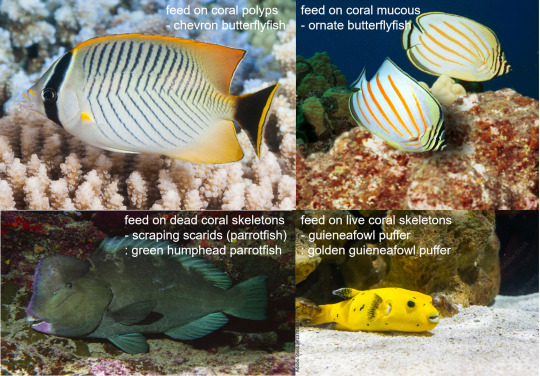
Credit: Francois Libert (chevron butterflyfish); Jim Nelson (ornate butterflyfish); Charlotte B (guieneafowl puffer); One People One Reef (scraping scarids)
This chronic predation can help regulate the abundance, distribution and fitness of some coral prey (Cox 1986; Rotjan & Lewis 2005; Rotjan et al. 2006). For instance, the selective predation of the coral-feeding fish Chaetodon unimaculatus on the corals Montipora verrucosa affects the coral growth, zonation and competitive ability (Cox 1986).
Coral groupers and trouts and their hunting partners
Coral groupers Plectropomus pessuliferus marisrubri and coral trouts Plectropomus leopardus feed on small fishes in the coral reefs (Vail, Manica & Bshary 2013). However, due to their relatively large body size, they cannot enter the coral reefs to conduct predation. Therefore, they cooperate with the hunting partners (Vail, Manica & Bshary 2013). For instance, the coral groupers Plectropomus pessuliferus marisrubri partner with the giant moray eel Gymnothorax javanicus and the Napoleon wrasse Cheilinus undulatus in predation (Bshary et al. 2006). The coral trouts Plectropomus leopardus hunt collaboratively with the octopus Octopus cyanea (Vail, Manica & Bshary 2013). The hunting partnership is beneficial as it increases the predation rate.
Collaborative hunting tactics (Bshary et al. 2006; Vail, Manica & Bshary 2013):
Coral groupers and trouts - indicate location of hidden prey in coral reefs to hunting partners and capture chased prey in open water using burst speed
Hunting partners:
Giant moray eels - have slender body to enter the coral crevices
Napoleon wrasses - have protractile jaws to suck out hidden prey or smash the reef matrix around the prey
Octopuses - have long arms to capture prey in cervices

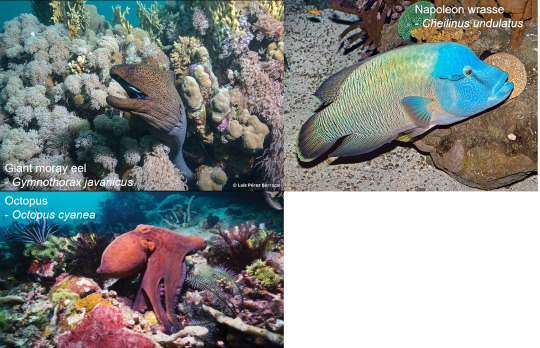
Credit: Georgette Douwma (Plectropomus pessuliferus marisrubri); Graham Edgar (Plectropomus leopardus); Luis Pérez Berrocal (Gymnothorax javanicus); Giuseppe Mazza (Cheilinus undulatus); Age Fotostock/Alamy Stock Photo (Octopus cyanea )
Flamingo tongue snail
Flamingo tongue snails (Cyphoma gibbosum) are gregarious sea snails that are found on the gorgonian corals, which possess distasteful toxins to protect them from being eaten (Whalen 2008). These tiny creatures are smaller than a postage stamp. Unlike most marine animals, they like to eat the gorgonian corals. They munch the toxin-saturated tissue until the hard skeleton of gorgonian corals using radula (modified tooth). One unique feature is that they can exploit the gorgonian toxins and incorporate them into the flaps of their brightly coloured mantle to make them awful to be eaten by fish (Whalen 2008).
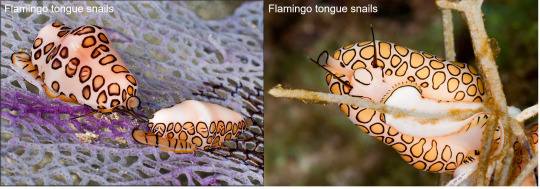
Credit: Linda Ianniello
This is the end of this blog. I hope these fantastic marine creatures in the coral reef ecosystem have amazed you.
References
Bshary, R, Hohner, A, Ait-el-Djoudi, K & Fricke, H 2006, ‘Interspecific communicative and coordinated hunting between groupers and giant moray eels in the Red Sea’, PLoS Biology, vol. 4, no. 12, p. e431.
Cole, AJ, Pratchett, MS & Jones, GP 2008, ‘Diversity and functional importance of coral‐feeding fishes on tropical coral reefs’, Fish and Fisheries, vol. 9, no. 3, pp. 286-307.
Cox, EF 1986, ‘The effects of a selective corallivore on growth rates and competition for space between two species of Hawaiian corals’, Journal of Experimental Marine Biology and Ecology, vol. 101, no. 2, pp. 161-174.
Rotjan, RD, Dimond, JL, Thornhill, DJ, Leichter, JJ, Helmuth, B, Kemp, DW & Lewis, SM 2006, ‘Chronic parrotfish grazing impedes coral recovery after bleaching’, Coral Reefs, vol. 25, pp. 361-368.
Rotjan, RD & Lewis, SM 2005, ‘Selective predation by parrotfishes on the reef coral Porites astreoides’, Marine Ecology Progress Series, vol. 305, pp. 193-201.
Vail, AL, Manica, A & Bshary, R 2013, ‘Referential gestures in fish collaborative hunting’, Nature Communications, vol. 4, no. 1, p. 1765.
Whalen, K 2008, ‘Biochemical warfare on coral reefs’, Oceanus, vol. 47, no. 1, p. 13.
Images or videos from external sources:
Age Fotostock/Alamy Stock Photo - https://www.worldwildlife.org/magazine/issues/spring-2019/articles/meet-the-master-of-camouflage-the-day-octopus
Charlotte B - https://stock.adobe.com/images/golden-guineafowl-puffer-fish-swimming-over-the-bottom-a-funny-and-venomous-tropical-fish-from-the-pacific-ocean/237039937
Francois Libert - https://uk.inaturalist.org/photos/171100563
Georgette Douwma - https://www.naturepl.com/stock-photo/red-sea-coral-grouper-%28plectropomus-pessuliferus-marisrubri%29-egypt-red-sea/search/detail-0_01448718.html
Giuseppe Mazza - https://www.monaconatureencyclopedia.com/cheilinus-undulatus/?lang=en
Graham Edgar - https://reeflifesurvey.com/species/plectropomus-leopardus/
Jim Nelson - https://www.projectnoah.org/spottings/2050146002
Linda Ianniello
- https://www.jaxshells.org/ryxx.htm
- https://www.jaxshells.org/6016.htm
Luis Pérez Berrocal - https://www.inaturalist.org/taxa/121000-Gymnothorax-javanicus
One People One Reef - https://onepeopleonereef.org/resources/fish-info/herbivorous-fishes/parrotfishes-scarids/
Raavya Bhattacharyya - https://travel.earth/best-coral-reefs-across-the-world/
Tim Hochgrebe - https://australian.museum/learn/animals/fishes/labridae-wrasses/
Wikipedia
- https://en.wikipedia.org/wiki/Filefish
- https://en.wikipedia.org/wiki/Parrotfish
- https://en.wikipedia.org/wiki/Pomacentridae
- https://en.wikipedia.org/wiki/Tetraodontidae
- https://en.wikipedia.org/wiki/Triggerfish
Wiktionary - https://en.wiktionary.org/wiki/butterflyfish
1 note
·
View note
Text
what’s up, doc?
medic!gn!reader
summary : coming from a long line of proficient healing magic-users, a letter requesting for your presence as nrc’s nurse is sent to your household, rather than the ebony carriage.
or ; headcanons and scenarios on what it’s like being nrc’s only medical staff surrounded by idiots who only know how to get hurt.
a/n : reader is implied to be the same age as the current third-years (18) and entered the school the same time as said third years.
‘labridae’ - is a fish that is well known for their role in the removal of parasites from larger carnivorous fishes. The larger fishes recognize the cleaner fish and will not devour it.

you were a fool to think that nrc was as prestigious as the rumours implied. your first day consisted of a meeting with the school’s seemingly incompetent principal and excited first years who though it was okay to roughhouse.
“with all due respect, headmaster, how am i supposed to be an apprentice if there is no one for me to learn from?” crossing your arms expectedly, you raise a questioning eyebrow at the old crow in front of you.
“your family are known to be quite knowledgeable in the art of healing, so i took it upon myself to be a gracious and thoughtful principal and saw this as a learning experience for their next heir! it’s quite convenient since the last nurse up and left, and perhaps i could even gain some connections…” sticking his nose in the air, he huffs proudly.
“what was that last part? i couldn’t hear you.”
“well, i am a very busy person, mx. medic, so i best be off!”
“wait-”
your specialised uniform consists of the classic blue scrubs underneath the standard lab coat of an nrc student, although, the only difference being that it doesn’t come with gloves and has a white armband engraved with a bold red plus symbol where a dorm insignia would be presented.
during your first year at nrc, you learn quickly that students don’t take too well with people who stick out too much, finding yourself often cornered by a group of people who think they’re tough and want to establish some sort of dominant image. but after just a few incidents, the students learn not to bother you too much.
“you think you’re so much better than the rest of us just because you were personally requested by the principal to attend, don’t’cha?” a student grips onto the collar of your shirt and lifts you to reach their face, the tips of your shoes being your only contact with the ground.
“i may be younger than you lot, but i am part of the faculty of this school, therefore, i am authorised to perform actions of discipline when and how i see fit. so, i highly suggest that you let me go or else you won’t have anyone to patch you up after i’m finished with you.”
the infirmary is located in a very secluded hallway from the rest of the school, so few students have taken upon themselves to use it as a safe area, away from the bustle and hustle of energetic and hectic students. and of course, who were you to say no?
“idia, i know i said that i’ll welcome you with open arms when you feel that your social battery is low and want someplace to hide, but for the third year in a row, that doesn’t mean i’m allowing you to modify the corner bed as your personal ‘recharge zone’, what happens if i need to treat someone?”
opening a packet of a candy mix, you tip them into a large, transparent jar. you laugh quietly when you hear the rapid pressing of his game console and sound effects of his game lower in volume by just a little. idia may seem uninterested in conversation most of the time, but you noticed that he gains a bit more confidence when talking with you.
“of course npcs like you wouldn’t understand, fuhehe. the ultra-rare, once in a lifetime healing stats you put in this place is out of this world.” without looking away from the game, he reaches out and makes grabbing motions at you. letting out a silent sigh, you begrudgingly drop two bits of hard candy into the palm of his hand. not wasting any time he throws them into his mouth and bites down into them.
“the internet connection is decent considering this place is in the middle of nowhere; the corner bed has five sockets along the wall rather than just two like the other beds; you bring me actual meals if i stay long enough and you also fill the sweets jar with the top quality stuff you only find in the easter egg shops the game devs add in limited edition events. it’s basically an easy win lol.”
if the botanical garden is for some reason not available then leona also takes refuge in your work space.
“instead of actively skipping classes, why don’t you try passing this year first, leona?”
“haah?? who do you think you are? i’ll crush you, small fry.”
you started to give your patients sweets after patching them up because you know lots of people find receiving medical treatment very uncomfortable. but now it kind of backfired since now everyone expects a little treat after being such a ‘big boy.’
“i can’t give you double the sweets just because you didn’t complain about me not having fish shaped plasters this time, floyd.” you hand him the usual: two green-apple gummy snakes.
“but labridae-senpai, i’ve been extra good today!” he pouts and whines while gripping the sweets in his hands, seemingly choking the snakes. your eye twitches slightly.
“i’ll give you just one more but that’s it.”
“yay!”
vil definitely asks for your input when trying new products for his skin or diets. he values your opinion because of your knowledge in nutrition. vil knows that you’ll be truthful and won’t reply with answers he’d only like to hear.
“vil, i know you want to reduce your fat intake for an upcoming photoshoot but i highly suggest you don’t cut out oily fish from your diet by this much, it’ll affect your academic performance.” you squint at the words on the sheet of paper containing vil’s suggested diet for the next few weeks, thinking of alternatives.
“hmm, yes, i was thinking the same thing but i was wondering if you could recommend some omega-3 vitamins, just temporarily so that it doesn’t hinder my performance that much,” the dorm leader proposes.
a light switches on in your head, grabbing a scrap piece of paper, you scribble a message onto it, “mhm, go to any pharmacy and request for ‘maritime drops,’ show them this paper and you should get the capsule for free. they can get a bit pricey depending on how fresh the batch was.”
you once heard the rumours of vil’s glowing skin during the opening ceremony and immediately knew the culprits of such a result. said culprits take up quite the percentage of causes of injury amongst the students on campus. could be because someone broke a deal or someone disagreed with the result of a deal. in your head, you thank the octatrio for keeping you busy with the people they slightly harm- but that’s besides the point. you doubt vil nor azul has any easy access to ingredients found only on the seabed seeing as you need special permission from the principal to exit school grounds, so that only leaves you with one other rather unfortunate theory.
you can only imagine what kind of odd payment a certain sneaky octopus has asked for in return…
“azul, please don’t tell me you wrung dry one of your mer-dorm members.” you note how azul’s office lacks one of the leech twins and you can only pray for floyd’s recovery (and for your candy stash because you just know he’ll be demanding them the next time he steps into your office).
“don’t worry, medic-san. floyd is making steady progress in rehabilitation,” azul smiles at you with no real feeling behind it.
you deadpan while sighing in exasperation, “here, give him this.” fishing through your deep pockets, you place down a small bottle filled with a fluorescent purple liquid on azul’s desk. looking towards jade’s direction you inform him, “tell floyd to bathe with three droplets of this stuff once a day and he should be able to walk again… eventually.”
the adeuce duo are lowkey kind of scared of you, especially after the dwarf mines incident during the first day.
“i get that you guys were gonna get expelled and all but couldn’t this wait until it was morning? as you said, none of you got hit in the head or found to be bleeding that much,” sending a small glare at the kneeling boys who you patched up first before demanding an explanation why they woke you up at the ass crack of dawn to have a check up.
“medic-senpai, isn’t it kind of your job to look after us no matter what?” yuu, the magicless now-student pipes up from a nearby chair, defending the duo, with a large rat-cat-thing dangling in their arms, snoring. it looks kind of gross.
“wanna say that again?” you ask expectedly. it was too early in the morning to argue too much.
“n-nothing…”
pinching the bridge of your nose, you throw them each a lollipop, “run along now, inform your housewarden that you’ve got an excusal from me.”
your family owns a few hospitals so you already had extensive knowledge on medicines and the such but what you lacked most of all was experience. so while you don’t regret attending nrc, you sometimes get tired of the same routine: students enter with scratches and bruises, you patch them up, give them sweets, send them off. you wished something more interesting would happen.
fine, if crowley wasn’t going to offer you proper education or enjoyment then you may as well do it yourself.
because of your seemingly lackadaisical attitude and nonchalance, people often mischaracterise you as somewhat friendly and forgiving just because you’re the medic.
when in reality, you’re just as bad, maybe even slightly worse than most of nrc’s students. hidden behind reassuring expressions and pretty words, you’re quite the cunning and sneaky one.
unbeknownst to the students and staff (besides crewel, he actually encourages it-), you experiment with them, testing out new concoctions or herbal treatments you’ve made constantly. how else are you supposed to earn the title of your family’s next heir if you couldn’t perform such a feat? the students all assume that it’s under the pretense that it has already been tested and sold to the public.
“don’t worry, this medication doesn’t have long lasting side effects. …probably.” smiling eerily at your unsuspecting patient, you scoop a portion of a bubbling green mixture and bring the spoon to their mouth, “cmon, say aah~”
nrc can only stand and watch in fear as you have a field day with all the recent overblots, riddle unfortunately being the very first victim to your questionable praise.
“now look to the left… mhm, no blot in your eyes either.” pocketing your retinoscope, you nod towards riddle, “you’re all good, no signs of leftover blot in your system but i would like for you to come to the infirmary for a regular check up before and after school for a week.”
“thank you, medic. i deeply apologise for the trouble i have caused for you.”
“no need to apologise, actually!” you wave him off.
riddle and a few other heartslabyul members within earshot look at you as if you’d grown a third head.
“look at all the damage you’ve caused, riddle. i really couldn’t thank you enough! here, have a lollipop, it’s strawberry and vanilla flavoured- oh, i can not wait for my clinic to flood in with students. things were getting ever so quiet! so many test subjects, so little time- i wouldn’t even know where to start~♡” with your eyes swirling with hidden craze, you swoon at the mass destruction that was once the heartslabyul garden, you can only imagine the number of scratched up students waiting in line at your door.
“psst- why is doc acting like that?”
“when they get like this, it’s best to just not say anything, ace…”

head empty, no thoughts. only caring for the twst boys-
just imagining being able to take proper care for the boys makes me brainrot so much 😭
#twisted wonderland#twst#twst x reader#medic!au#reader insert#gender neutral!reader#gn#twisted wonderland x reader#very self indulgent
2K notes
·
View notes
Text
Humphead Wrasse!
The humphead wrasse (Cheilinus undulatus) is the largest species in the family Labridae
Males can grow up to 2 meters and weigh 180kg although that is rare and the average length is just under a meter
Females on average grow just over a meter
Unfortunately they are considered endangered due to aggressive over fishing
If you have read this far why not follow us @animalfacthub for daily animal facts and pics!
-

📷1: Public Domain

📷2: “Napoleon Fish by Gustavo Gerdel.jpg” by Gustavo Gerdel on Wikimedia Commons (CC BY-SA 4.0)

📷3: “Humphead wrasse melb aquarium.jpg” by Fir0002 on Wikimedia Commons GFDL 1.2
3 notes
·
View notes
Photo

@DeepPacificPod: Our alternative logo is actually this fish, Napolean or Humphead wrasse, Cheilinus undulatus, an endangered species on the IUCN Red List and the largest member of the Labridae family, called "tanguisson" gi fino'Chamorro https://t.co/PgkYp94WS2 https://t.co/AQxsbCRtDc
0 notes